Current Development in Accounting: Analysis and Evaluation
VerifiedAdded on 2022/08/24
|14
|2938
|18
Homework Assignment
AI Summary
This assignment delves into the current developments in accounting, focusing on the concepts of faithful representation and neutrality as defined by the AASB Conceptual Framework. It explores the importance of these concepts in ensuring the reliability and usefulness of financial information for stakeholders. The assignment then examines the benefits and criticisms of conceptual frameworks, evaluating their worth in guiding accounting standard setting and practice. Finally, it analyzes the historical cost measurement technique, discussing its advantages, disadvantages, and its role in financial reporting and decision-making. The student utilizes the prescribed textbook and academic writing guidelines to provide a comprehensive analysis of these critical accounting topics.
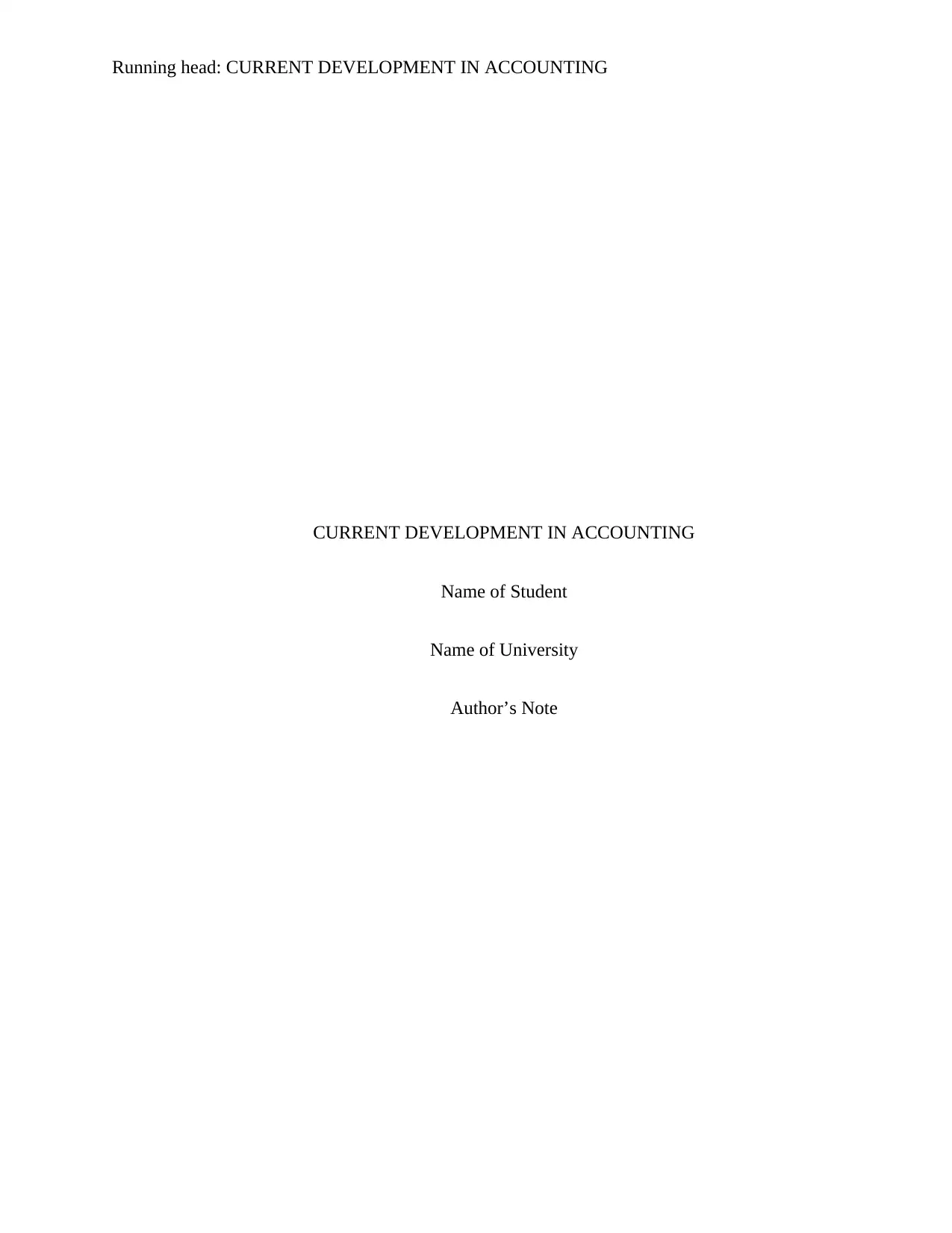
Running head: CURRENT DEVELOPMENT IN ACCOUNTING
CURRENT DEVELOPMENT IN ACCOUNTING
Name of Student
Name of University
Author’s Note
CURRENT DEVELOPMENT IN ACCOUNTING
Name of Student
Name of University
Author’s Note
Paraphrase This Document
Need a fresh take? Get an instant paraphrase of this document with our AI Paraphraser
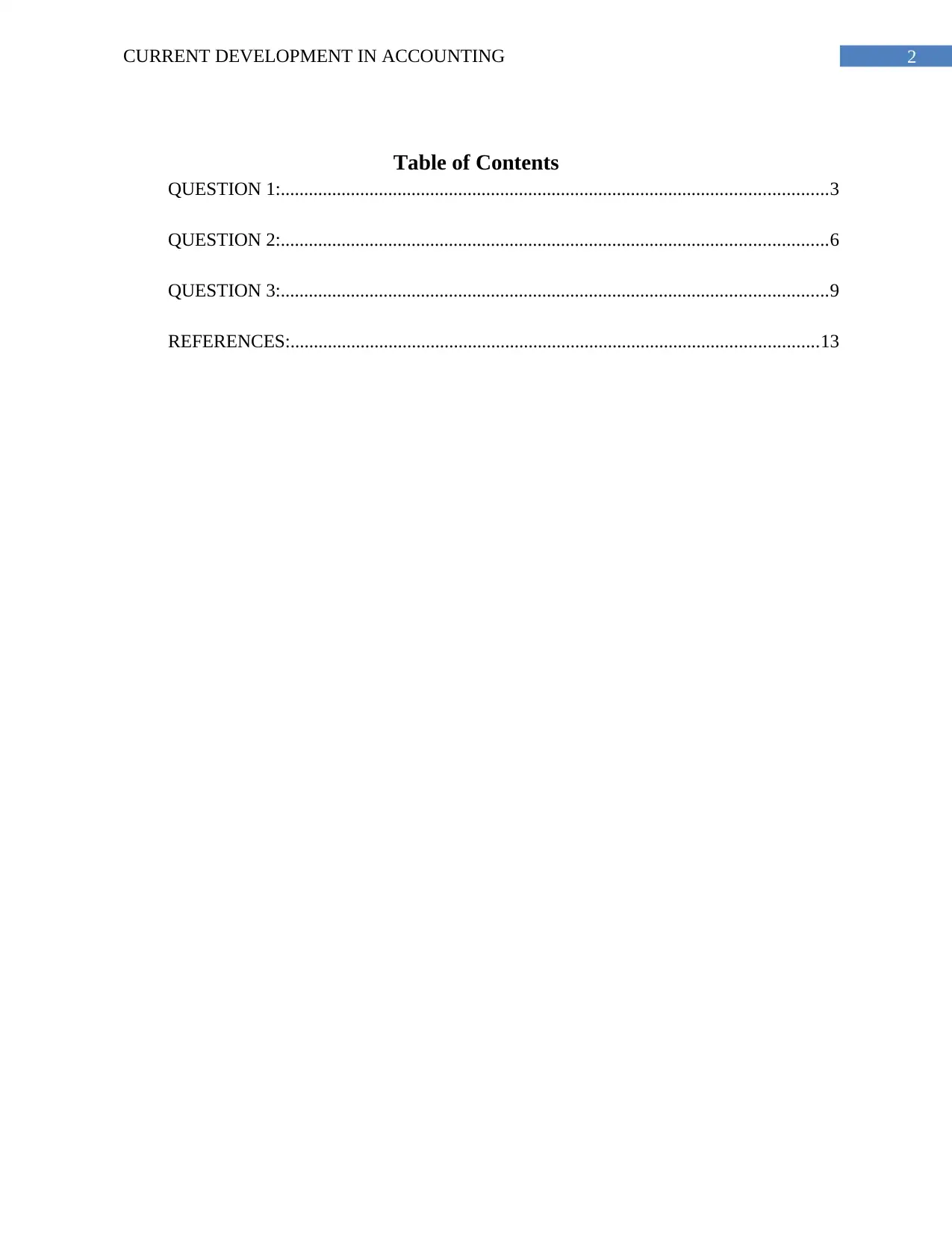
2CURRENT DEVELOPMENT IN ACCOUNTING
Table of Contents
QUESTION 1:.....................................................................................................................3
QUESTION 2:.....................................................................................................................6
QUESTION 3:.....................................................................................................................9
REFERENCES:.................................................................................................................13
Table of Contents
QUESTION 1:.....................................................................................................................3
QUESTION 2:.....................................................................................................................6
QUESTION 3:.....................................................................................................................9
REFERENCES:.................................................................................................................13
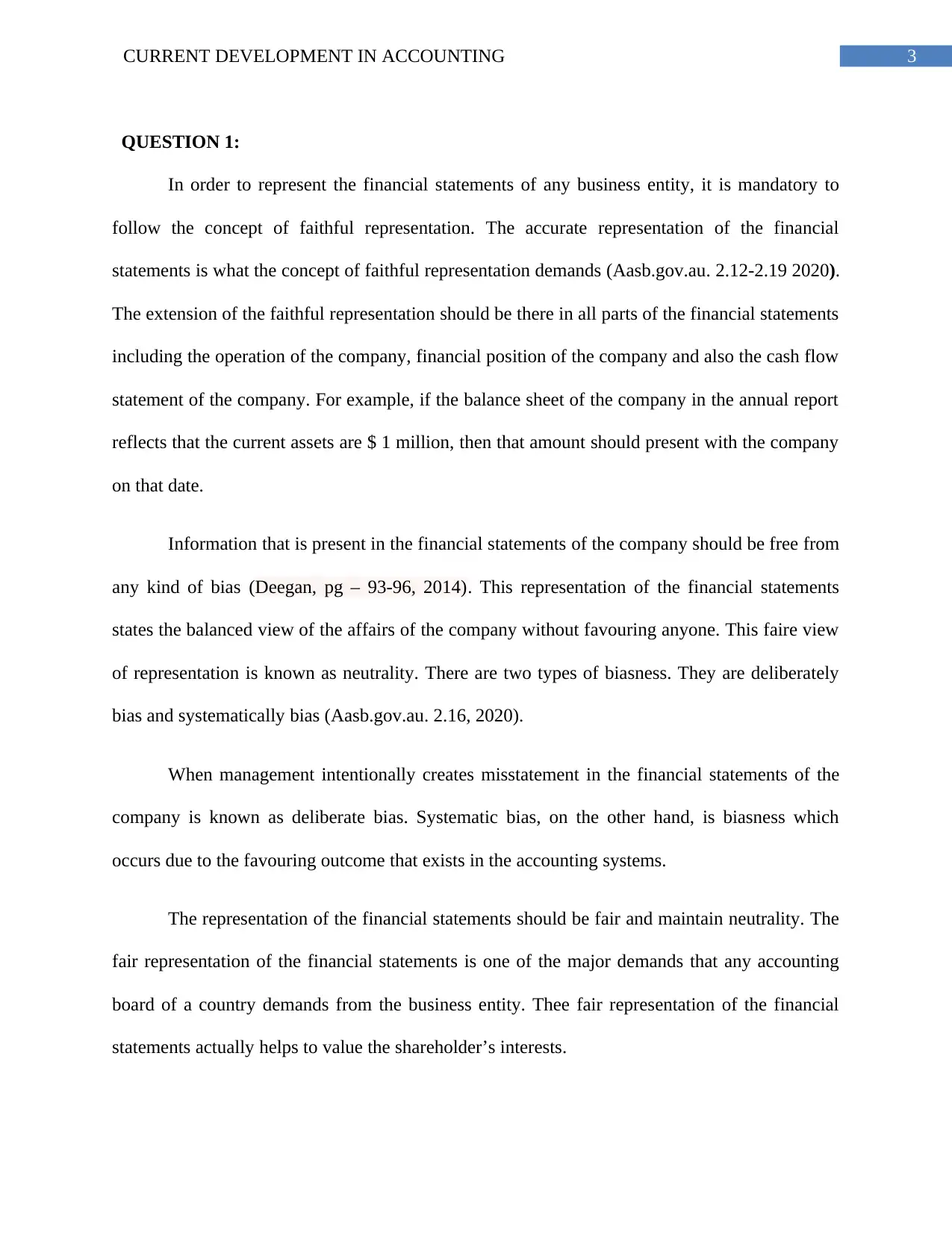
3CURRENT DEVELOPMENT IN ACCOUNTING
QUESTION 1:
In order to represent the financial statements of any business entity, it is mandatory to
follow the concept of faithful representation. The accurate representation of the financial
statements is what the concept of faithful representation demands (Aasb.gov.au. 2.12-2.19 2020).
The extension of the faithful representation should be there in all parts of the financial statements
including the operation of the company, financial position of the company and also the cash flow
statement of the company. For example, if the balance sheet of the company in the annual report
reflects that the current assets are $ 1 million, then that amount should present with the company
on that date.
Information that is present in the financial statements of the company should be free from
any kind of bias (Deegan, pg – 93-96, 2014). This representation of the financial statements
states the balanced view of the affairs of the company without favouring anyone. This faire view
of representation is known as neutrality. There are two types of biasness. They are deliberately
bias and systematically bias (Aasb.gov.au. 2.16, 2020).
When management intentionally creates misstatement in the financial statements of the
company is known as deliberate bias. Systematic bias, on the other hand, is biasness which
occurs due to the favouring outcome that exists in the accounting systems.
The representation of the financial statements should be fair and maintain neutrality. The
fair representation of the financial statements is one of the major demands that any accounting
board of a country demands from the business entity. Thee fair representation of the financial
statements actually helps to value the shareholder’s interests.
QUESTION 1:
In order to represent the financial statements of any business entity, it is mandatory to
follow the concept of faithful representation. The accurate representation of the financial
statements is what the concept of faithful representation demands (Aasb.gov.au. 2.12-2.19 2020).
The extension of the faithful representation should be there in all parts of the financial statements
including the operation of the company, financial position of the company and also the cash flow
statement of the company. For example, if the balance sheet of the company in the annual report
reflects that the current assets are $ 1 million, then that amount should present with the company
on that date.
Information that is present in the financial statements of the company should be free from
any kind of bias (Deegan, pg – 93-96, 2014). This representation of the financial statements
states the balanced view of the affairs of the company without favouring anyone. This faire view
of representation is known as neutrality. There are two types of biasness. They are deliberately
bias and systematically bias (Aasb.gov.au. 2.16, 2020).
When management intentionally creates misstatement in the financial statements of the
company is known as deliberate bias. Systematic bias, on the other hand, is biasness which
occurs due to the favouring outcome that exists in the accounting systems.
The representation of the financial statements should be fair and maintain neutrality. The
fair representation of the financial statements is one of the major demands that any accounting
board of a country demands from the business entity. Thee fair representation of the financial
statements actually helps to value the shareholder’s interests.
⊘ This is a preview!⊘
Do you want full access?
Subscribe today to unlock all pages.

Trusted by 1+ million students worldwide
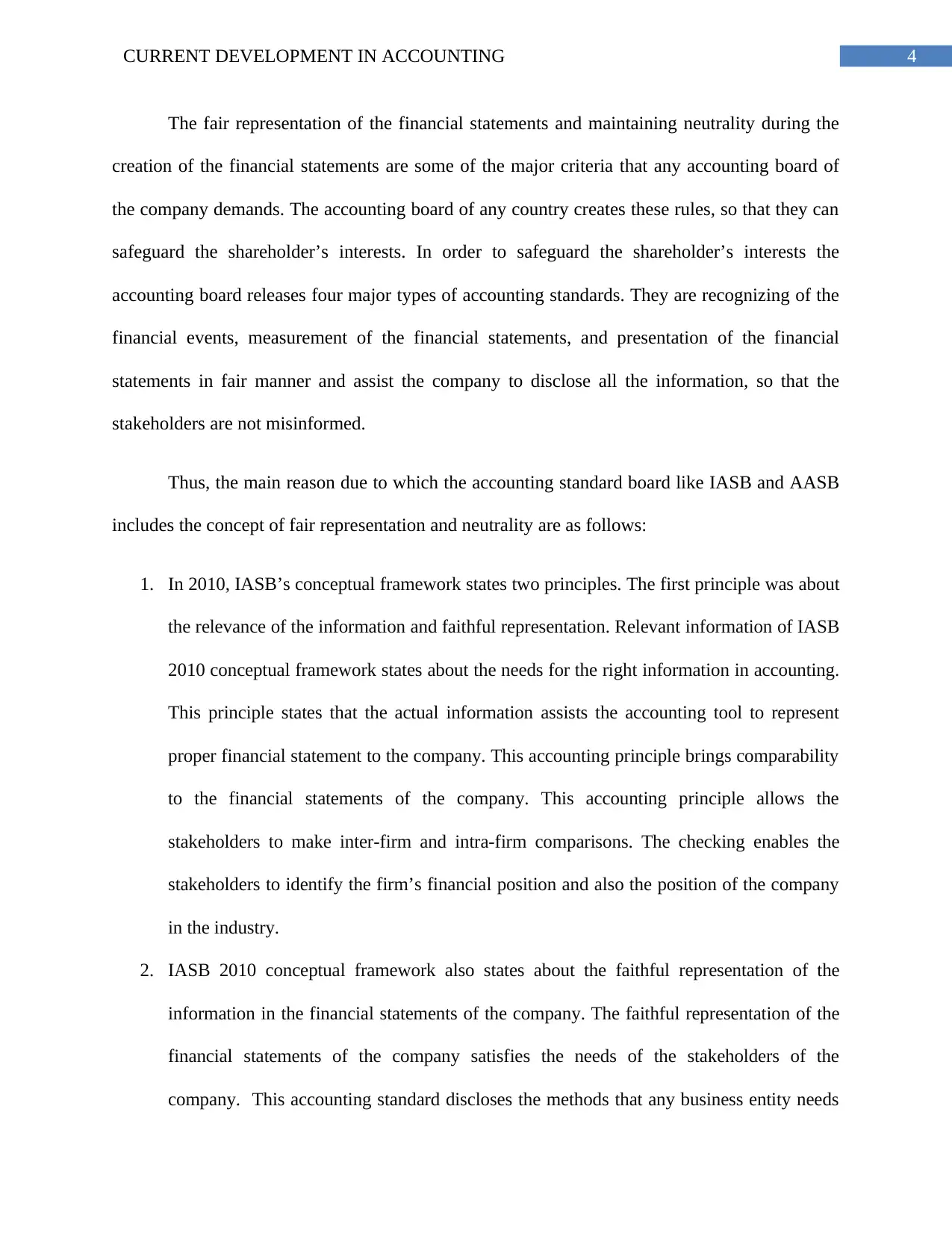
4CURRENT DEVELOPMENT IN ACCOUNTING
The fair representation of the financial statements and maintaining neutrality during the
creation of the financial statements are some of the major criteria that any accounting board of
the company demands. The accounting board of any country creates these rules, so that they can
safeguard the shareholder’s interests. In order to safeguard the shareholder’s interests the
accounting board releases four major types of accounting standards. They are recognizing of the
financial events, measurement of the financial statements, and presentation of the financial
statements in fair manner and assist the company to disclose all the information, so that the
stakeholders are not misinformed.
Thus, the main reason due to which the accounting standard board like IASB and AASB
includes the concept of fair representation and neutrality are as follows:
1. In 2010, IASB’s conceptual framework states two principles. The first principle was about
the relevance of the information and faithful representation. Relevant information of IASB
2010 conceptual framework states about the needs for the right information in accounting.
This principle states that the actual information assists the accounting tool to represent
proper financial statement to the company. This accounting principle brings comparability
to the financial statements of the company. This accounting principle allows the
stakeholders to make inter-firm and intra-firm comparisons. The checking enables the
stakeholders to identify the firm’s financial position and also the position of the company
in the industry.
2. IASB 2010 conceptual framework also states about the faithful representation of the
information in the financial statements of the company. The faithful representation of the
financial statements of the company satisfies the needs of the stakeholders of the
company. This accounting standard discloses the methods that any business entity needs
The fair representation of the financial statements and maintaining neutrality during the
creation of the financial statements are some of the major criteria that any accounting board of
the company demands. The accounting board of any country creates these rules, so that they can
safeguard the shareholder’s interests. In order to safeguard the shareholder’s interests the
accounting board releases four major types of accounting standards. They are recognizing of the
financial events, measurement of the financial statements, and presentation of the financial
statements in fair manner and assist the company to disclose all the information, so that the
stakeholders are not misinformed.
Thus, the main reason due to which the accounting standard board like IASB and AASB
includes the concept of fair representation and neutrality are as follows:
1. In 2010, IASB’s conceptual framework states two principles. The first principle was about
the relevance of the information and faithful representation. Relevant information of IASB
2010 conceptual framework states about the needs for the right information in accounting.
This principle states that the actual information assists the accounting tool to represent
proper financial statement to the company. This accounting principle brings comparability
to the financial statements of the company. This accounting principle allows the
stakeholders to make inter-firm and intra-firm comparisons. The checking enables the
stakeholders to identify the firm’s financial position and also the position of the company
in the industry.
2. IASB 2010 conceptual framework also states about the faithful representation of the
information in the financial statements of the company. The faithful representation of the
financial statements of the company satisfies the needs of the stakeholders of the
company. This accounting standard discloses the methods that any business entity needs
Paraphrase This Document
Need a fresh take? Get an instant paraphrase of this document with our AI Paraphraser
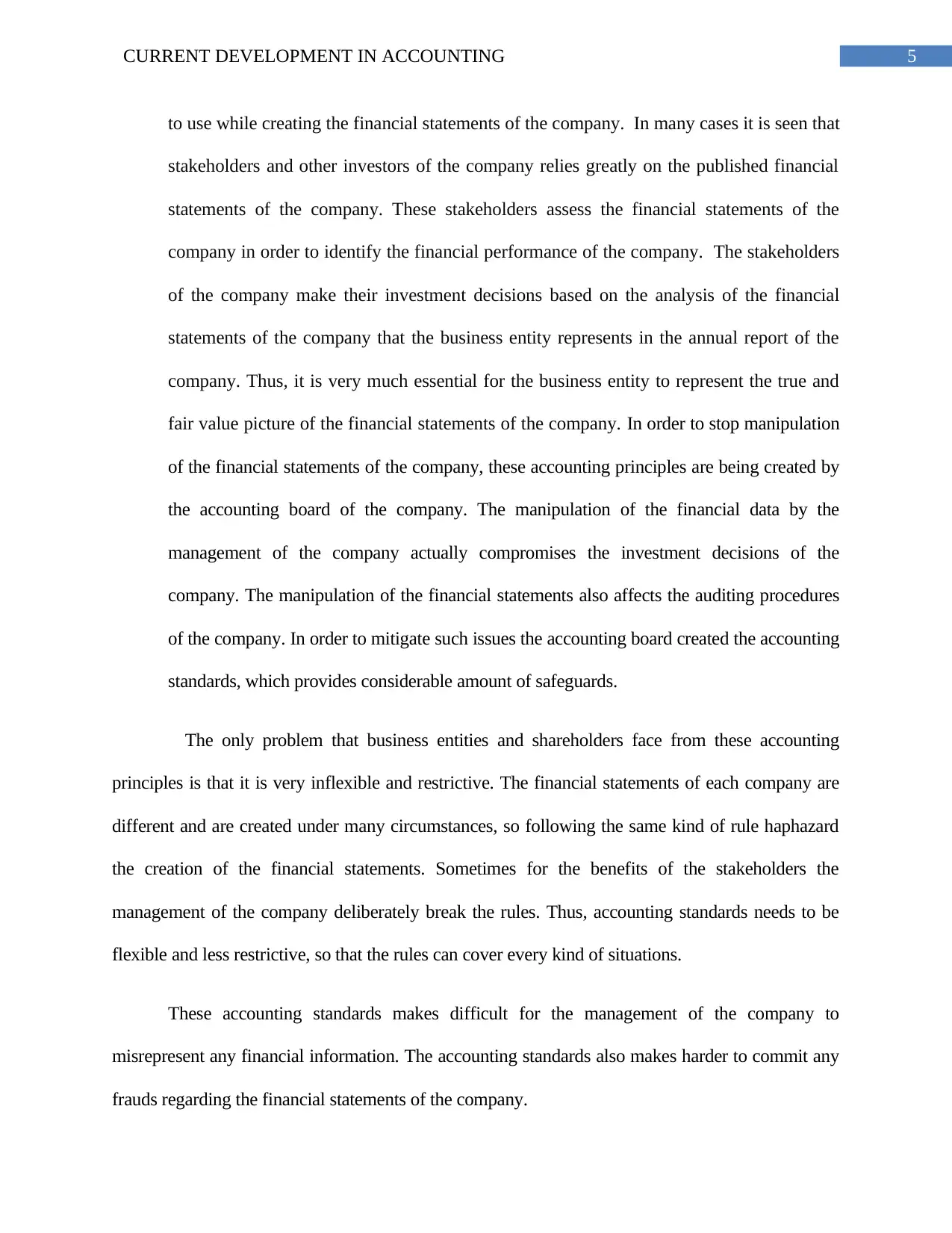
5CURRENT DEVELOPMENT IN ACCOUNTING
to use while creating the financial statements of the company. In many cases it is seen that
stakeholders and other investors of the company relies greatly on the published financial
statements of the company. These stakeholders assess the financial statements of the
company in order to identify the financial performance of the company. The stakeholders
of the company make their investment decisions based on the analysis of the financial
statements of the company that the business entity represents in the annual report of the
company. Thus, it is very much essential for the business entity to represent the true and
fair value picture of the financial statements of the company. In order to stop manipulation
of the financial statements of the company, these accounting principles are being created by
the accounting board of the company. The manipulation of the financial data by the
management of the company actually compromises the investment decisions of the
company. The manipulation of the financial statements also affects the auditing procedures
of the company. In order to mitigate such issues the accounting board created the accounting
standards, which provides considerable amount of safeguards.
The only problem that business entities and shareholders face from these accounting
principles is that it is very inflexible and restrictive. The financial statements of each company are
different and are created under many circumstances, so following the same kind of rule haphazard
the creation of the financial statements. Sometimes for the benefits of the stakeholders the
management of the company deliberately break the rules. Thus, accounting standards needs to be
flexible and less restrictive, so that the rules can cover every kind of situations.
These accounting standards makes difficult for the management of the company to
misrepresent any financial information. The accounting standards also makes harder to commit any
frauds regarding the financial statements of the company.
to use while creating the financial statements of the company. In many cases it is seen that
stakeholders and other investors of the company relies greatly on the published financial
statements of the company. These stakeholders assess the financial statements of the
company in order to identify the financial performance of the company. The stakeholders
of the company make their investment decisions based on the analysis of the financial
statements of the company that the business entity represents in the annual report of the
company. Thus, it is very much essential for the business entity to represent the true and
fair value picture of the financial statements of the company. In order to stop manipulation
of the financial statements of the company, these accounting principles are being created by
the accounting board of the company. The manipulation of the financial data by the
management of the company actually compromises the investment decisions of the
company. The manipulation of the financial statements also affects the auditing procedures
of the company. In order to mitigate such issues the accounting board created the accounting
standards, which provides considerable amount of safeguards.
The only problem that business entities and shareholders face from these accounting
principles is that it is very inflexible and restrictive. The financial statements of each company are
different and are created under many circumstances, so following the same kind of rule haphazard
the creation of the financial statements. Sometimes for the benefits of the stakeholders the
management of the company deliberately break the rules. Thus, accounting standards needs to be
flexible and less restrictive, so that the rules can cover every kind of situations.
These accounting standards makes difficult for the management of the company to
misrepresent any financial information. The accounting standards also makes harder to commit any
frauds regarding the financial statements of the company.
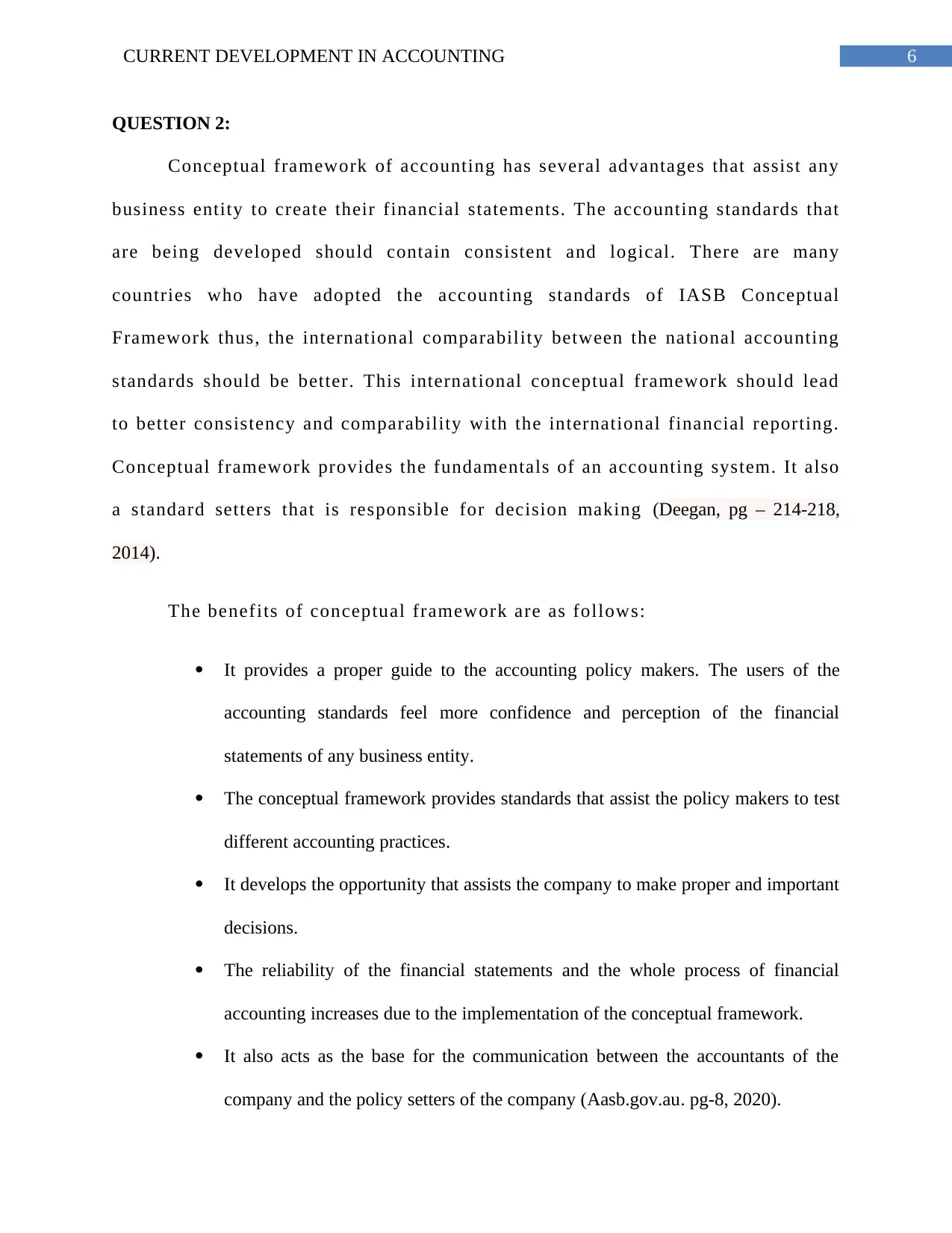
6CURRENT DEVELOPMENT IN ACCOUNTING
QUESTION 2:
Conceptual framework of accounting has several advantages that assist any
business entity to create their financial statements. The accounting standards that
are being developed should contain consistent and logical. There are many
countries who have adopted the accounting standards of IASB Conceptual
Framework thus, the international comparability between the national accounting
standards should be better. This international conceptual framework should lead
to better consistency and comparability with the international financial reporting.
Conceptual framework provides the fundamentals of an accounting system. It also
a standard setters that is responsible for decision making (Deegan, pg – 214-218,
2014).
The benefits of conceptual framework are as follows:
It provides a proper guide to the accounting policy makers. The users of the
accounting standards feel more confidence and perception of the financial
statements of any business entity.
The conceptual framework provides standards that assist the policy makers to test
different accounting practices.
It develops the opportunity that assists the company to make proper and important
decisions.
The reliability of the financial statements and the whole process of financial
accounting increases due to the implementation of the conceptual framework.
It also acts as the base for the communication between the accountants of the
company and the policy setters of the company (Aasb.gov.au. pg-8, 2020).
QUESTION 2:
Conceptual framework of accounting has several advantages that assist any
business entity to create their financial statements. The accounting standards that
are being developed should contain consistent and logical. There are many
countries who have adopted the accounting standards of IASB Conceptual
Framework thus, the international comparability between the national accounting
standards should be better. This international conceptual framework should lead
to better consistency and comparability with the international financial reporting.
Conceptual framework provides the fundamentals of an accounting system. It also
a standard setters that is responsible for decision making (Deegan, pg – 214-218,
2014).
The benefits of conceptual framework are as follows:
It provides a proper guide to the accounting policy makers. The users of the
accounting standards feel more confidence and perception of the financial
statements of any business entity.
The conceptual framework provides standards that assist the policy makers to test
different accounting practices.
It develops the opportunity that assists the company to make proper and important
decisions.
The reliability of the financial statements and the whole process of financial
accounting increases due to the implementation of the conceptual framework.
It also acts as the base for the communication between the accountants of the
company and the policy setters of the company (Aasb.gov.au. pg-8, 2020).
⊘ This is a preview!⊘
Do you want full access?
Subscribe today to unlock all pages.

Trusted by 1+ million students worldwide
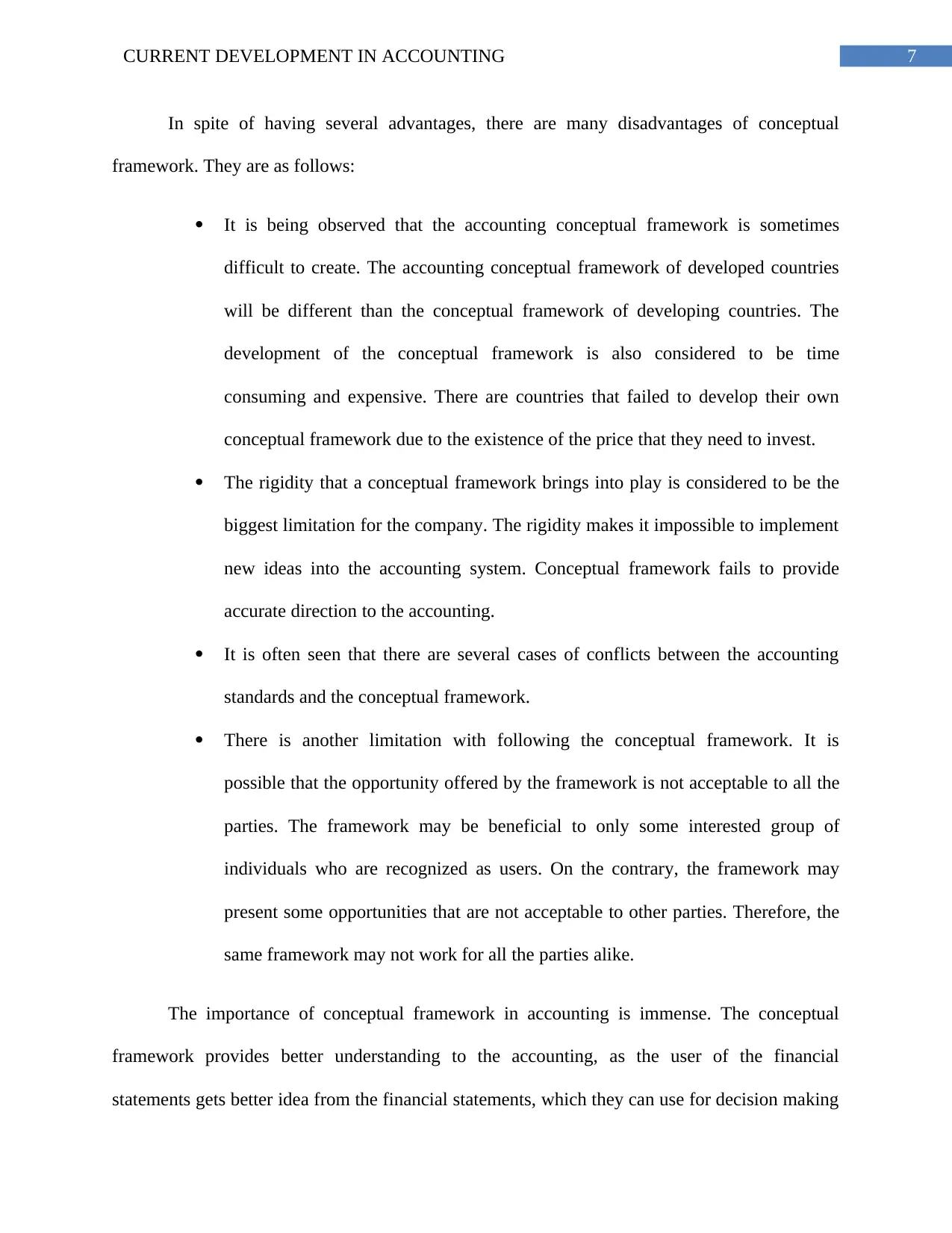
7CURRENT DEVELOPMENT IN ACCOUNTING
In spite of having several advantages, there are many disadvantages of conceptual
framework. They are as follows:
It is being observed that the accounting conceptual framework is sometimes
difficult to create. The accounting conceptual framework of developed countries
will be different than the conceptual framework of developing countries. The
development of the conceptual framework is also considered to be time
consuming and expensive. There are countries that failed to develop their own
conceptual framework due to the existence of the price that they need to invest.
The rigidity that a conceptual framework brings into play is considered to be the
biggest limitation for the company. The rigidity makes it impossible to implement
new ideas into the accounting system. Conceptual framework fails to provide
accurate direction to the accounting.
It is often seen that there are several cases of conflicts between the accounting
standards and the conceptual framework.
There is another limitation with following the conceptual framework. It is
possible that the opportunity offered by the framework is not acceptable to all the
parties. The framework may be beneficial to only some interested group of
individuals who are recognized as users. On the contrary, the framework may
present some opportunities that are not acceptable to other parties. Therefore, the
same framework may not work for all the parties alike.
The importance of conceptual framework in accounting is immense. The conceptual
framework provides better understanding to the accounting, as the user of the financial
statements gets better idea from the financial statements, which they can use for decision making
In spite of having several advantages, there are many disadvantages of conceptual
framework. They are as follows:
It is being observed that the accounting conceptual framework is sometimes
difficult to create. The accounting conceptual framework of developed countries
will be different than the conceptual framework of developing countries. The
development of the conceptual framework is also considered to be time
consuming and expensive. There are countries that failed to develop their own
conceptual framework due to the existence of the price that they need to invest.
The rigidity that a conceptual framework brings into play is considered to be the
biggest limitation for the company. The rigidity makes it impossible to implement
new ideas into the accounting system. Conceptual framework fails to provide
accurate direction to the accounting.
It is often seen that there are several cases of conflicts between the accounting
standards and the conceptual framework.
There is another limitation with following the conceptual framework. It is
possible that the opportunity offered by the framework is not acceptable to all the
parties. The framework may be beneficial to only some interested group of
individuals who are recognized as users. On the contrary, the framework may
present some opportunities that are not acceptable to other parties. Therefore, the
same framework may not work for all the parties alike.
The importance of conceptual framework in accounting is immense. The conceptual
framework provides better understanding to the accounting, as the user of the financial
statements gets better idea from the financial statements, which they can use for decision making
Paraphrase This Document
Need a fresh take? Get an instant paraphrase of this document with our AI Paraphraser
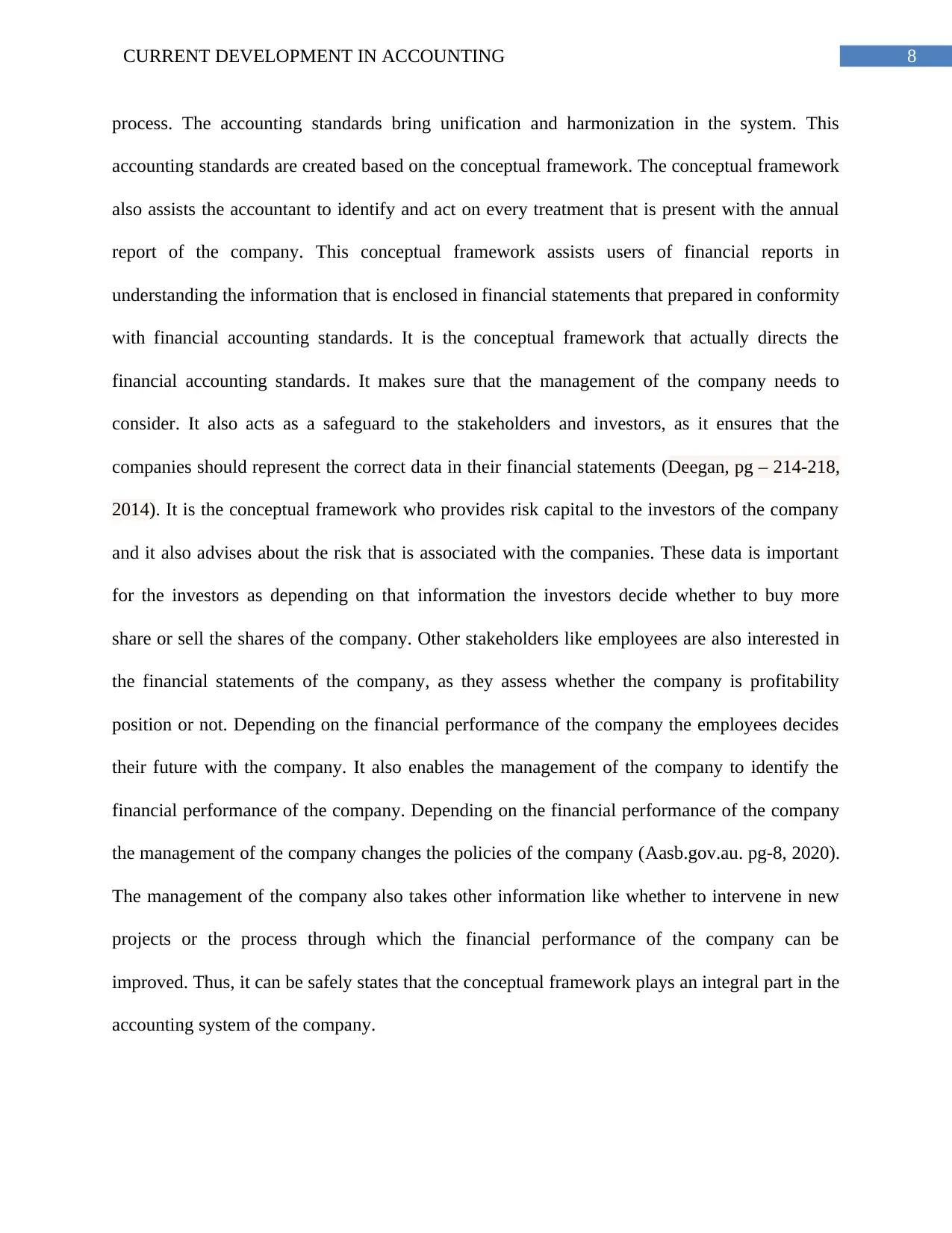
8CURRENT DEVELOPMENT IN ACCOUNTING
process. The accounting standards bring unification and harmonization in the system. This
accounting standards are created based on the conceptual framework. The conceptual framework
also assists the accountant to identify and act on every treatment that is present with the annual
report of the company. This conceptual framework assists users of financial reports in
understanding the information that is enclosed in financial statements that prepared in conformity
with financial accounting standards. It is the conceptual framework that actually directs the
financial accounting standards. It makes sure that the management of the company needs to
consider. It also acts as a safeguard to the stakeholders and investors, as it ensures that the
companies should represent the correct data in their financial statements (Deegan, pg – 214-218,
2014). It is the conceptual framework who provides risk capital to the investors of the company
and it also advises about the risk that is associated with the companies. These data is important
for the investors as depending on that information the investors decide whether to buy more
share or sell the shares of the company. Other stakeholders like employees are also interested in
the financial statements of the company, as they assess whether the company is profitability
position or not. Depending on the financial performance of the company the employees decides
their future with the company. It also enables the management of the company to identify the
financial performance of the company. Depending on the financial performance of the company
the management of the company changes the policies of the company (Aasb.gov.au. pg-8, 2020).
The management of the company also takes other information like whether to intervene in new
projects or the process through which the financial performance of the company can be
improved. Thus, it can be safely states that the conceptual framework plays an integral part in the
accounting system of the company.
process. The accounting standards bring unification and harmonization in the system. This
accounting standards are created based on the conceptual framework. The conceptual framework
also assists the accountant to identify and act on every treatment that is present with the annual
report of the company. This conceptual framework assists users of financial reports in
understanding the information that is enclosed in financial statements that prepared in conformity
with financial accounting standards. It is the conceptual framework that actually directs the
financial accounting standards. It makes sure that the management of the company needs to
consider. It also acts as a safeguard to the stakeholders and investors, as it ensures that the
companies should represent the correct data in their financial statements (Deegan, pg – 214-218,
2014). It is the conceptual framework who provides risk capital to the investors of the company
and it also advises about the risk that is associated with the companies. These data is important
for the investors as depending on that information the investors decide whether to buy more
share or sell the shares of the company. Other stakeholders like employees are also interested in
the financial statements of the company, as they assess whether the company is profitability
position or not. Depending on the financial performance of the company the employees decides
their future with the company. It also enables the management of the company to identify the
financial performance of the company. Depending on the financial performance of the company
the management of the company changes the policies of the company (Aasb.gov.au. pg-8, 2020).
The management of the company also takes other information like whether to intervene in new
projects or the process through which the financial performance of the company can be
improved. Thus, it can be safely states that the conceptual framework plays an integral part in the
accounting system of the company.
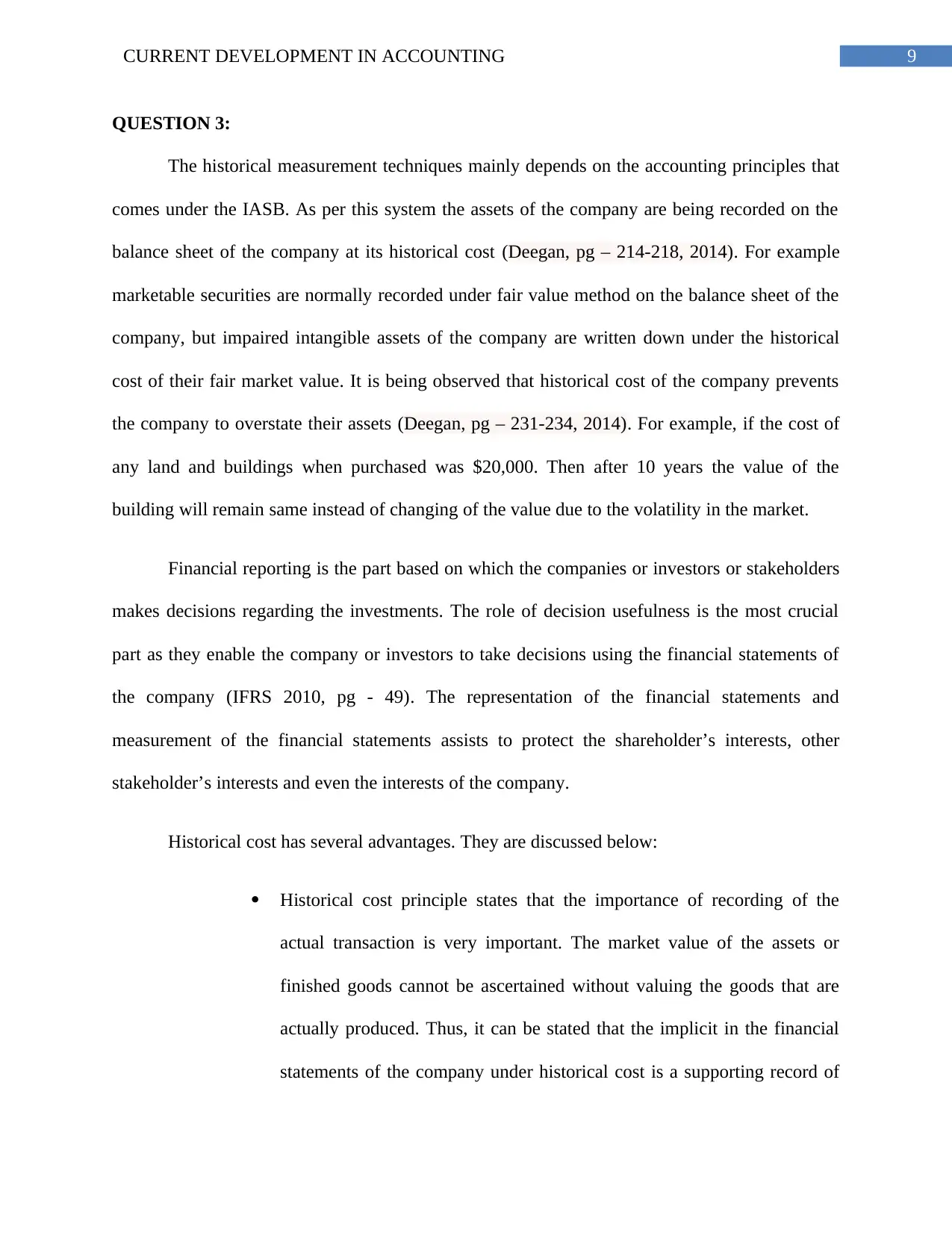
9CURRENT DEVELOPMENT IN ACCOUNTING
QUESTION 3:
The historical measurement techniques mainly depends on the accounting principles that
comes under the IASB. As per this system the assets of the company are being recorded on the
balance sheet of the company at its historical cost (Deegan, pg – 214-218, 2014). For example
marketable securities are normally recorded under fair value method on the balance sheet of the
company, but impaired intangible assets of the company are written down under the historical
cost of their fair market value. It is being observed that historical cost of the company prevents
the company to overstate their assets (Deegan, pg – 231-234, 2014). For example, if the cost of
any land and buildings when purchased was $20,000. Then after 10 years the value of the
building will remain same instead of changing of the value due to the volatility in the market.
Financial reporting is the part based on which the companies or investors or stakeholders
makes decisions regarding the investments. The role of decision usefulness is the most crucial
part as they enable the company or investors to take decisions using the financial statements of
the company (IFRS 2010, pg - 49). The representation of the financial statements and
measurement of the financial statements assists to protect the shareholder’s interests, other
stakeholder’s interests and even the interests of the company.
Historical cost has several advantages. They are discussed below:
Historical cost principle states that the importance of recording of the
actual transaction is very important. The market value of the assets or
finished goods cannot be ascertained without valuing the goods that are
actually produced. Thus, it can be stated that the implicit in the financial
statements of the company under historical cost is a supporting record of
QUESTION 3:
The historical measurement techniques mainly depends on the accounting principles that
comes under the IASB. As per this system the assets of the company are being recorded on the
balance sheet of the company at its historical cost (Deegan, pg – 214-218, 2014). For example
marketable securities are normally recorded under fair value method on the balance sheet of the
company, but impaired intangible assets of the company are written down under the historical
cost of their fair market value. It is being observed that historical cost of the company prevents
the company to overstate their assets (Deegan, pg – 231-234, 2014). For example, if the cost of
any land and buildings when purchased was $20,000. Then after 10 years the value of the
building will remain same instead of changing of the value due to the volatility in the market.
Financial reporting is the part based on which the companies or investors or stakeholders
makes decisions regarding the investments. The role of decision usefulness is the most crucial
part as they enable the company or investors to take decisions using the financial statements of
the company (IFRS 2010, pg - 49). The representation of the financial statements and
measurement of the financial statements assists to protect the shareholder’s interests, other
stakeholder’s interests and even the interests of the company.
Historical cost has several advantages. They are discussed below:
Historical cost principle states that the importance of recording of the
actual transaction is very important. The market value of the assets or
finished goods cannot be ascertained without valuing the goods that are
actually produced. Thus, it can be stated that the implicit in the financial
statements of the company under historical cost is a supporting record of
⊘ This is a preview!⊘
Do you want full access?
Subscribe today to unlock all pages.

Trusted by 1+ million students worldwide
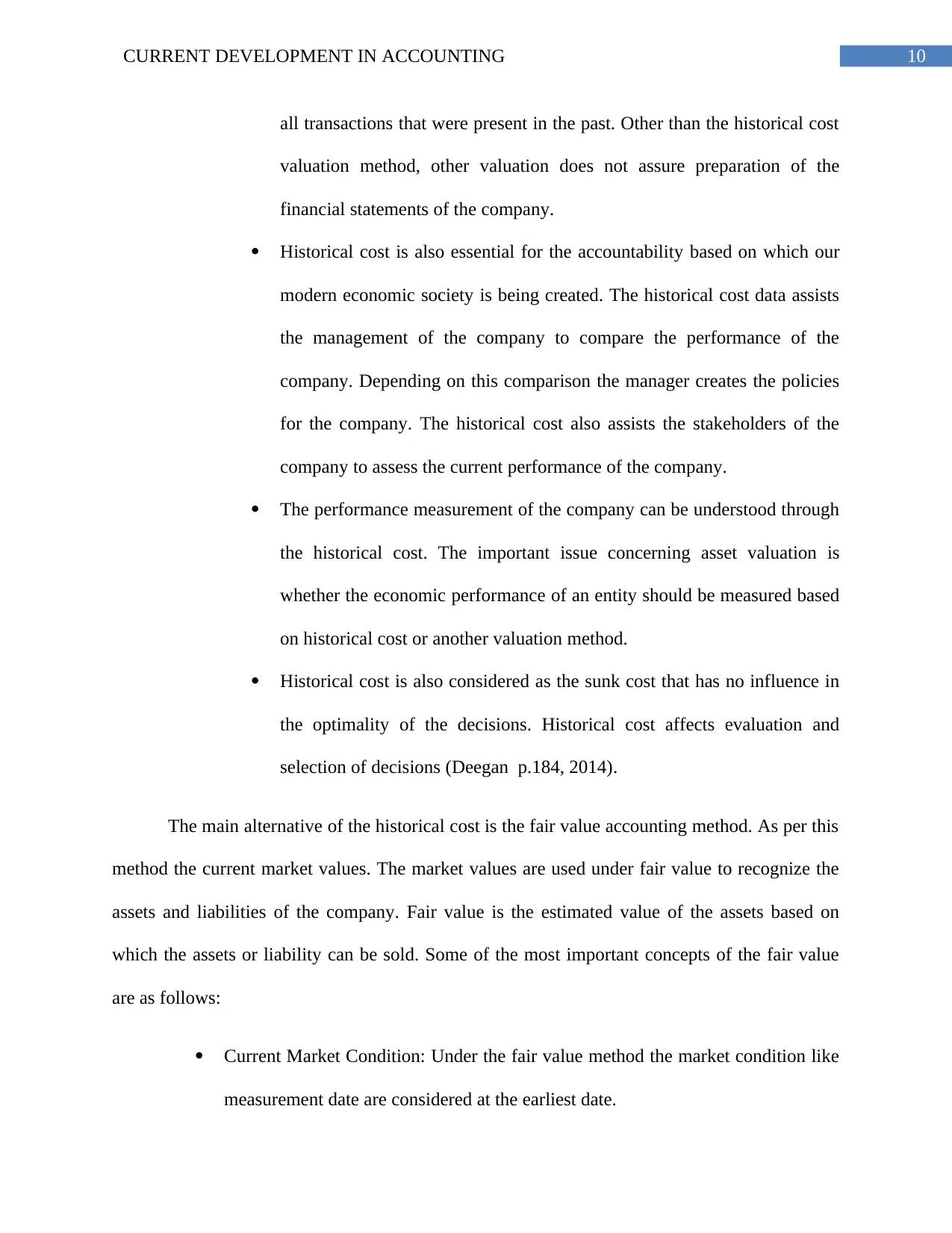
10CURRENT DEVELOPMENT IN ACCOUNTING
all transactions that were present in the past. Other than the historical cost
valuation method, other valuation does not assure preparation of the
financial statements of the company.
Historical cost is also essential for the accountability based on which our
modern economic society is being created. The historical cost data assists
the management of the company to compare the performance of the
company. Depending on this comparison the manager creates the policies
for the company. The historical cost also assists the stakeholders of the
company to assess the current performance of the company.
The performance measurement of the company can be understood through
the historical cost. The important issue concerning asset valuation is
whether the economic performance of an entity should be measured based
on historical cost or another valuation method.
Historical cost is also considered as the sunk cost that has no influence in
the optimality of the decisions. Historical cost affects evaluation and
selection of decisions (Deegan p.184, 2014).
The main alternative of the historical cost is the fair value accounting method. As per this
method the current market values. The market values are used under fair value to recognize the
assets and liabilities of the company. Fair value is the estimated value of the assets based on
which the assets or liability can be sold. Some of the most important concepts of the fair value
are as follows:
Current Market Condition: Under the fair value method the market condition like
measurement date are considered at the earliest date.
all transactions that were present in the past. Other than the historical cost
valuation method, other valuation does not assure preparation of the
financial statements of the company.
Historical cost is also essential for the accountability based on which our
modern economic society is being created. The historical cost data assists
the management of the company to compare the performance of the
company. Depending on this comparison the manager creates the policies
for the company. The historical cost also assists the stakeholders of the
company to assess the current performance of the company.
The performance measurement of the company can be understood through
the historical cost. The important issue concerning asset valuation is
whether the economic performance of an entity should be measured based
on historical cost or another valuation method.
Historical cost is also considered as the sunk cost that has no influence in
the optimality of the decisions. Historical cost affects evaluation and
selection of decisions (Deegan p.184, 2014).
The main alternative of the historical cost is the fair value accounting method. As per this
method the current market values. The market values are used under fair value to recognize the
assets and liabilities of the company. Fair value is the estimated value of the assets based on
which the assets or liability can be sold. Some of the most important concepts of the fair value
are as follows:
Current Market Condition: Under the fair value method the market condition like
measurement date are considered at the earliest date.
Paraphrase This Document
Need a fresh take? Get an instant paraphrase of this document with our AI Paraphraser
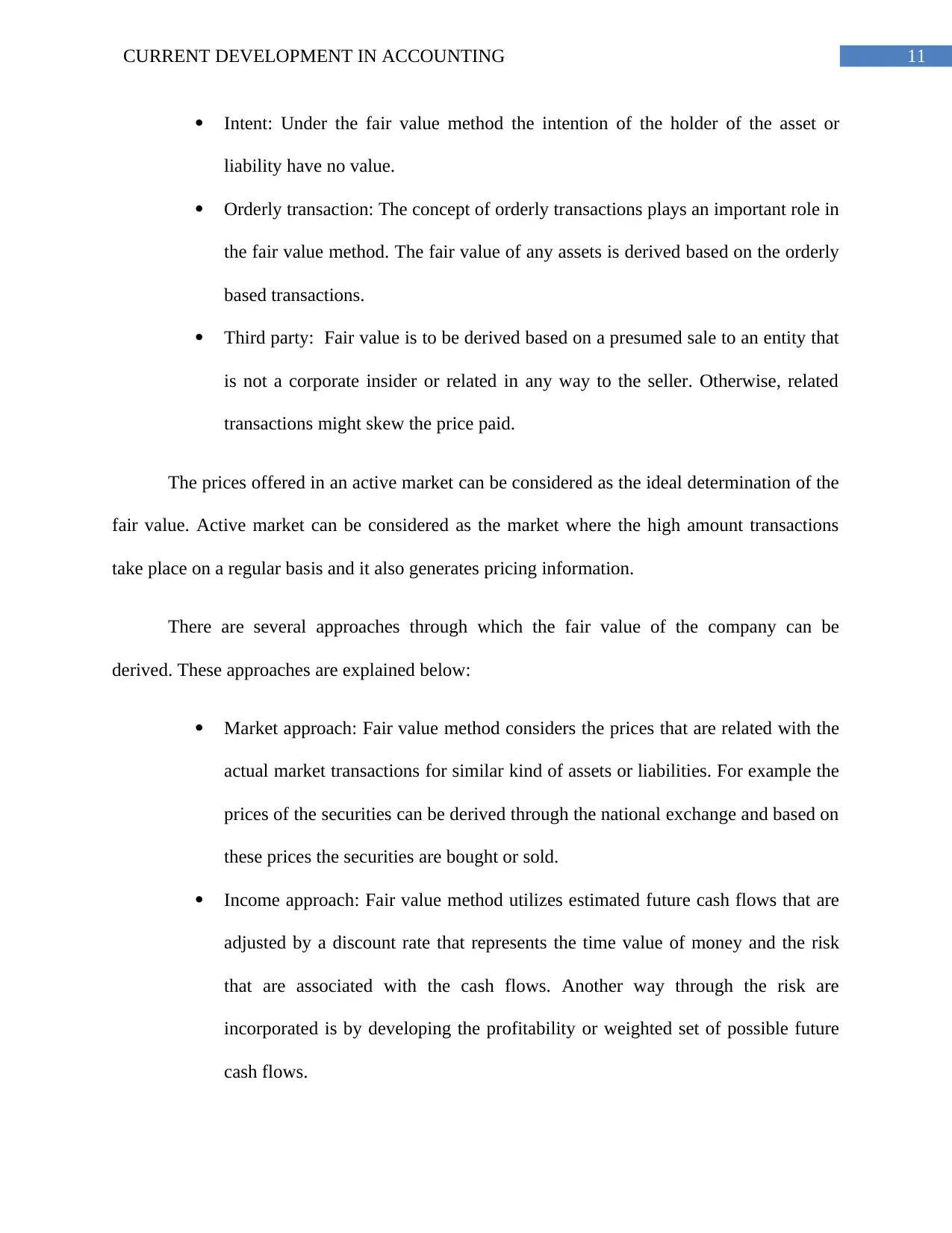
11CURRENT DEVELOPMENT IN ACCOUNTING
Intent: Under the fair value method the intention of the holder of the asset or
liability have no value.
Orderly transaction: The concept of orderly transactions plays an important role in
the fair value method. The fair value of any assets is derived based on the orderly
based transactions.
Third party: Fair value is to be derived based on a presumed sale to an entity that
is not a corporate insider or related in any way to the seller. Otherwise, related
transactions might skew the price paid.
The prices offered in an active market can be considered as the ideal determination of the
fair value. Active market can be considered as the market where the high amount transactions
take place on a regular basis and it also generates pricing information.
There are several approaches through which the fair value of the company can be
derived. These approaches are explained below:
Market approach: Fair value method considers the prices that are related with the
actual market transactions for similar kind of assets or liabilities. For example the
prices of the securities can be derived through the national exchange and based on
these prices the securities are bought or sold.
Income approach: Fair value method utilizes estimated future cash flows that are
adjusted by a discount rate that represents the time value of money and the risk
that are associated with the cash flows. Another way through the risk are
incorporated is by developing the profitability or weighted set of possible future
cash flows.
Intent: Under the fair value method the intention of the holder of the asset or
liability have no value.
Orderly transaction: The concept of orderly transactions plays an important role in
the fair value method. The fair value of any assets is derived based on the orderly
based transactions.
Third party: Fair value is to be derived based on a presumed sale to an entity that
is not a corporate insider or related in any way to the seller. Otherwise, related
transactions might skew the price paid.
The prices offered in an active market can be considered as the ideal determination of the
fair value. Active market can be considered as the market where the high amount transactions
take place on a regular basis and it also generates pricing information.
There are several approaches through which the fair value of the company can be
derived. These approaches are explained below:
Market approach: Fair value method considers the prices that are related with the
actual market transactions for similar kind of assets or liabilities. For example the
prices of the securities can be derived through the national exchange and based on
these prices the securities are bought or sold.
Income approach: Fair value method utilizes estimated future cash flows that are
adjusted by a discount rate that represents the time value of money and the risk
that are associated with the cash flows. Another way through the risk are
incorporated is by developing the profitability or weighted set of possible future
cash flows.
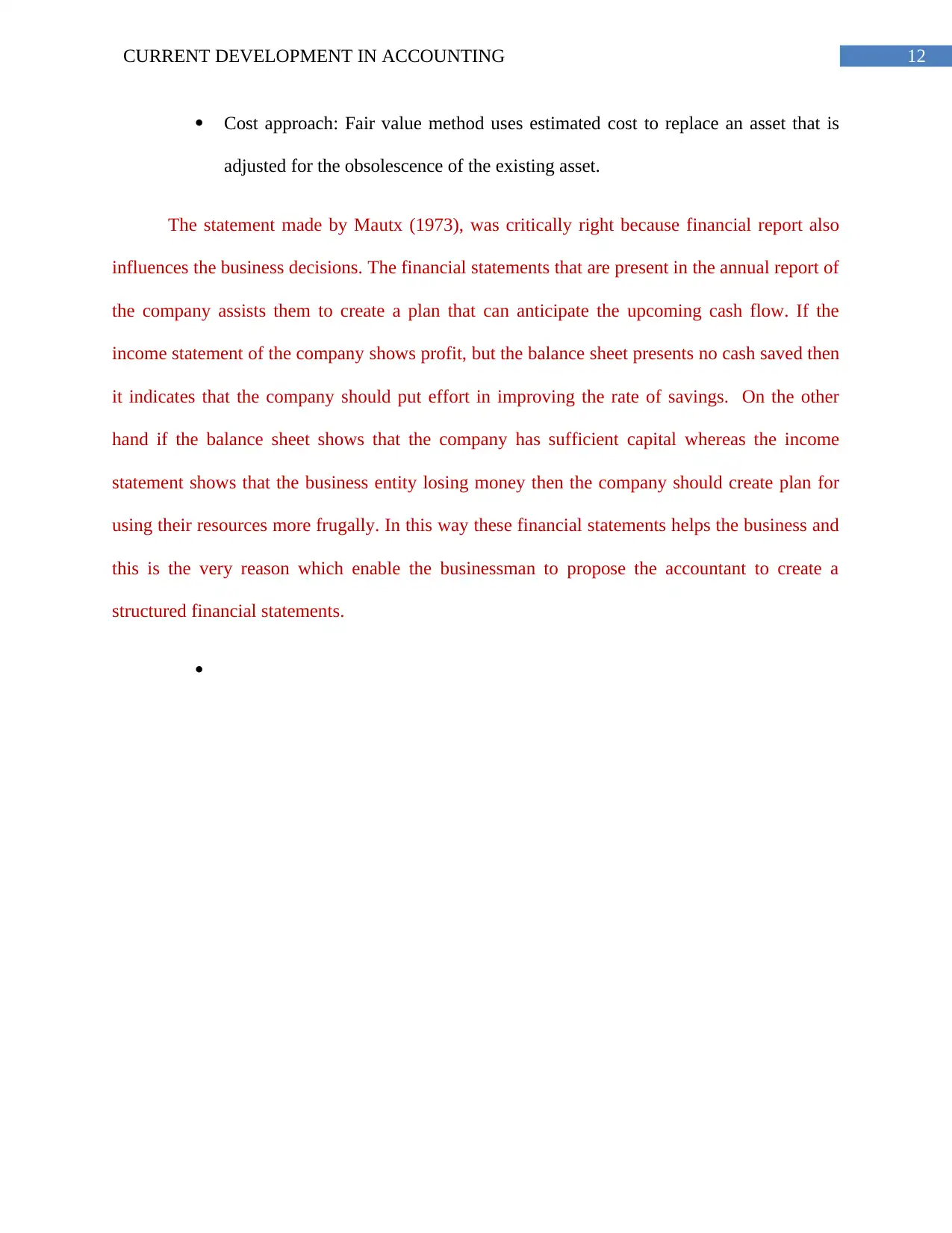
12CURRENT DEVELOPMENT IN ACCOUNTING
Cost approach: Fair value method uses estimated cost to replace an asset that is
adjusted for the obsolescence of the existing asset.
The statement made by Mautx (1973), was critically right because financial report also
influences the business decisions. The financial statements that are present in the annual report of
the company assists them to create a plan that can anticipate the upcoming cash flow. If the
income statement of the company shows profit, but the balance sheet presents no cash saved then
it indicates that the company should put effort in improving the rate of savings. On the other
hand if the balance sheet shows that the company has sufficient capital whereas the income
statement shows that the business entity losing money then the company should create plan for
using their resources more frugally. In this way these financial statements helps the business and
this is the very reason which enable the businessman to propose the accountant to create a
structured financial statements.
Cost approach: Fair value method uses estimated cost to replace an asset that is
adjusted for the obsolescence of the existing asset.
The statement made by Mautx (1973), was critically right because financial report also
influences the business decisions. The financial statements that are present in the annual report of
the company assists them to create a plan that can anticipate the upcoming cash flow. If the
income statement of the company shows profit, but the balance sheet presents no cash saved then
it indicates that the company should put effort in improving the rate of savings. On the other
hand if the balance sheet shows that the company has sufficient capital whereas the income
statement shows that the business entity losing money then the company should create plan for
using their resources more frugally. In this way these financial statements helps the business and
this is the very reason which enable the businessman to propose the accountant to create a
structured financial statements.
⊘ This is a preview!⊘
Do you want full access?
Subscribe today to unlock all pages.

Trusted by 1+ million students worldwide
1 out of 14
Related Documents
Your All-in-One AI-Powered Toolkit for Academic Success.
+13062052269
info@desklib.com
Available 24*7 on WhatsApp / Email
![[object Object]](/_next/static/media/star-bottom.7253800d.svg)
Unlock your academic potential
Copyright © 2020–2025 A2Z Services. All Rights Reserved. Developed and managed by ZUCOL.





